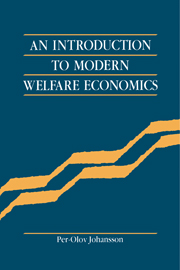Book contents
- Frontmatter
- Contents
- Preface
- 1 Introduction
- 2 Pareto optimality in a market economy
- 3 The compensation principle and the social welfare function
- 4 Measuring welfare changes
- 5 Market failures — causes and welfare consequences
- 6 Public choice
- 7 A ‘Smorgasbord’ of further topics
- 8 How to overcome the problem of preference revelation: practical methodologies
- 9 Cost-benefit analysis
- 10 The treatment of risk
- Appendix: The consumer and the firm
- References
- Index
10 - The treatment of risk
Published online by Cambridge University Press: 23 December 2009
- Frontmatter
- Contents
- Preface
- 1 Introduction
- 2 Pareto optimality in a market economy
- 3 The compensation principle and the social welfare function
- 4 Measuring welfare changes
- 5 Market failures — causes and welfare consequences
- 6 Public choice
- 7 A ‘Smorgasbord’ of further topics
- 8 How to overcome the problem of preference revelation: practical methodologies
- 9 Cost-benefit analysis
- 10 The treatment of risk
- Appendix: The consumer and the firm
- References
- Index
Summary
Up until now we have generally assumed that people know for sure what will happen in the future, for example, what their incomes will be, the prices of all commodities, and so on. This is not a very realistic description of the reality faced by the far from non-negligible part of mankind that has mislaid its crystal ball. People face risks every time they take a shower, walk across the street, or make an investment. It seems reasonable to distinguish between risk, which refers to situations where probabilities are knowable, and uncertainty proper, which applies to situations where probabilities cannot even be defined. In this chapter, we will mostly deal with the former class of situations, although the terms risk and uncertainty are used interchangeably. After defining concepts like expected utility and risk aversion, the chapter focuses on decision criteria to be used when evaluating risky projects. The focus is on the so-called expected utility theory. The reader interested in other approaches is referred to Thaler and Ziemba (1988).
A first example
Let us discuss some possible decision strategies when the outcome of a project (an investment) is uncertain, as in table 10.1. Suppose that the investigator estimates that the probability is exactly one-half that the proposed project will earn a net benefit of $5 million. The probability is also one-half that the project will be a failure and produce a loss of $5 million.
- Type
- Chapter
- Information
- An Introduction to Modern Welfare Economics , pp. 135 - 146Publisher: Cambridge University PressPrint publication year: 1991



